The Gemstones of Ancient Egypt
May 5, 2021 Program Summary: presented by Derek Yoost
Summary prepared by Andy Thompson, MSDC Secretary
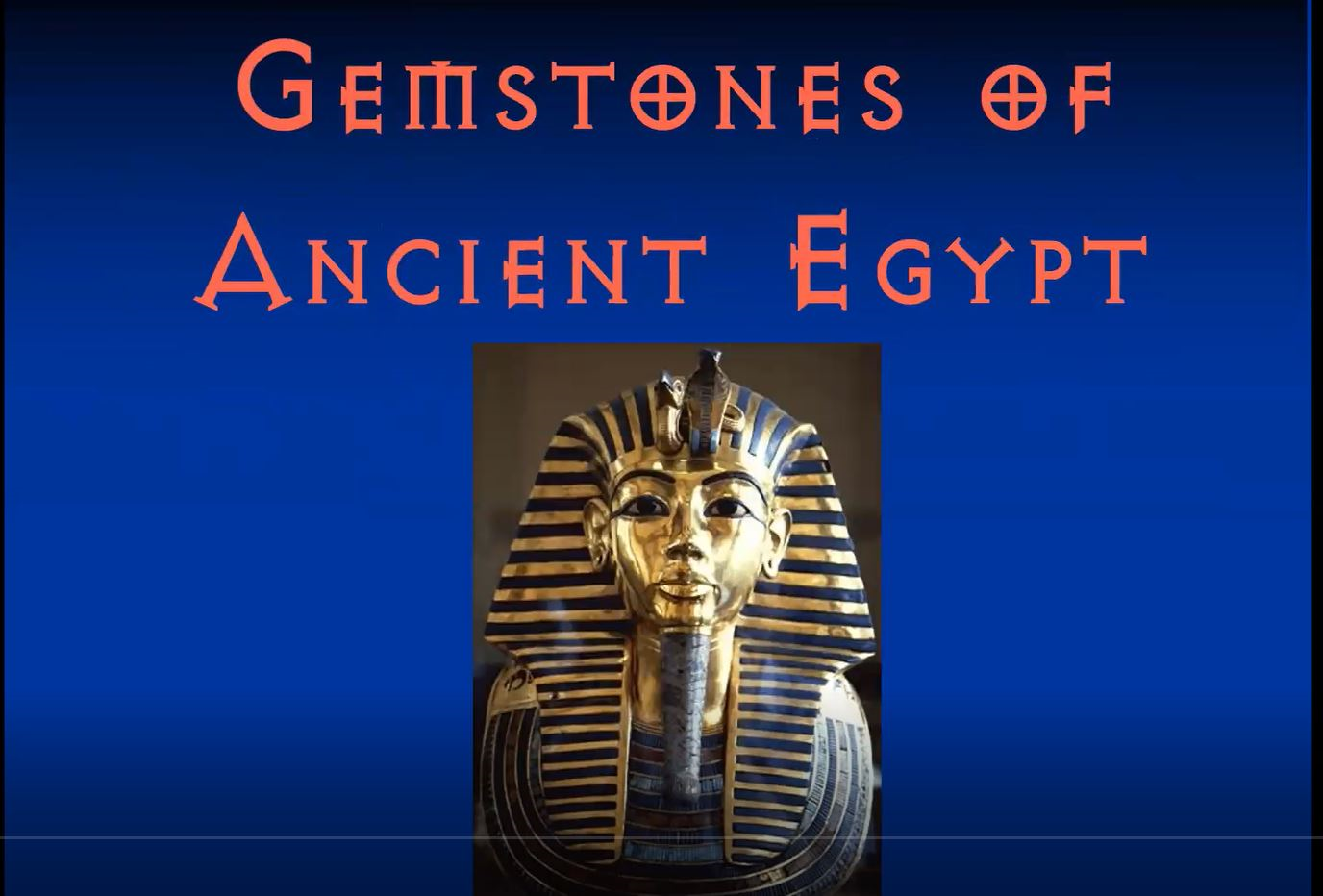
Yury Kalish, MSDC Vice President for programs, introduced Derek Yoost, the evening’s presenter. Derek is a life-long fossil, meteorite, and mineral collector and is active with several clubs in the northern New Jersey area. He began his presentation by saying his approach would be more general than technical and will not include charts or formulas.
The ancient Egyptians, he noted, created beautiful jewelry and artifacts by making use primarily of four materials: lapis lazuli rocks, carnelian, Persian turquoise, and high-carat gold. Each has its own story of where it originated and how it was valued in the Egyptian culture.
Lapis
For the Egyptians, as for the earlier Babylonian and Sumerian cultures, lapis was the most highly valued material, and for them, rarer than gold. Derek pointed out that it is a rock, not a mineral, and typically is composed of lazurite with lesser amounts of calcite and pyrite.
What contributed to the high value of lapis was its scarcity. For the Egyptians and the earlier civilizations, the only known source for lapis was Afghanistan’s Sar-e-Sang mines. They were located in the remote and rugged northeast mountainous region of the country, near today’s border with Tajikistan. There were no roads into the remote Kush mountains and no modern equipment for excavation. All the mining had to be done by hand. The precious rocks had to be transported on the backs of men or pack animals.
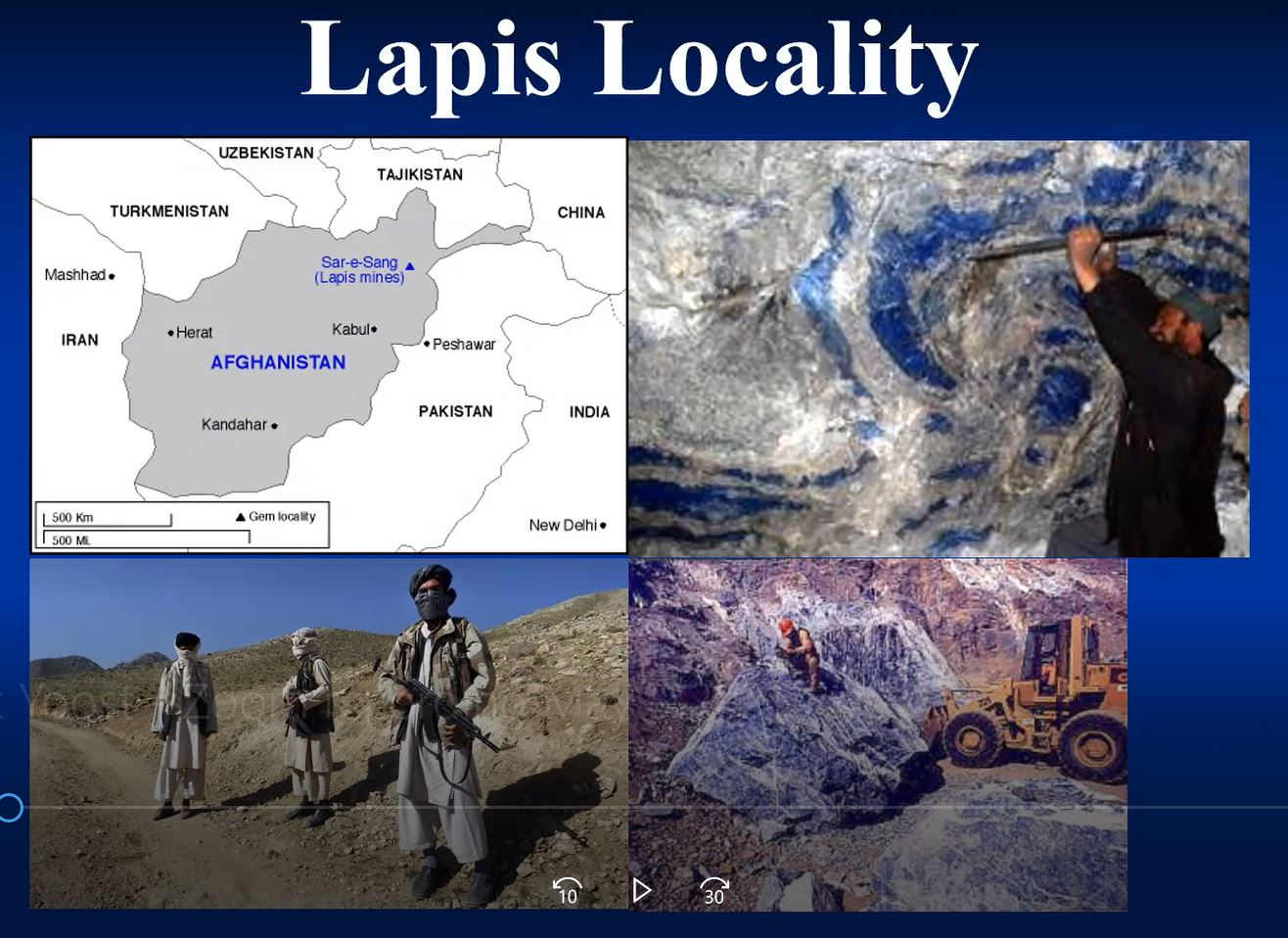
One of the most important and common uses for lapis was for jewelry, especially for scarabs, images of the dung beetle. The example shown below to the lower left, made of lapis and gold, represented the sun god which rolled across the sky each day. Derek noted that the dung beetle scarab, as well as the two breastplate images above the scarab, contain the four main materials commonly featured in so many Egyptian artifacts: lapis, carnelian, Persian turquoise, and gold. His presentation to MSDC focused on those materials and included numerous examples of their use in artistic artifacts.
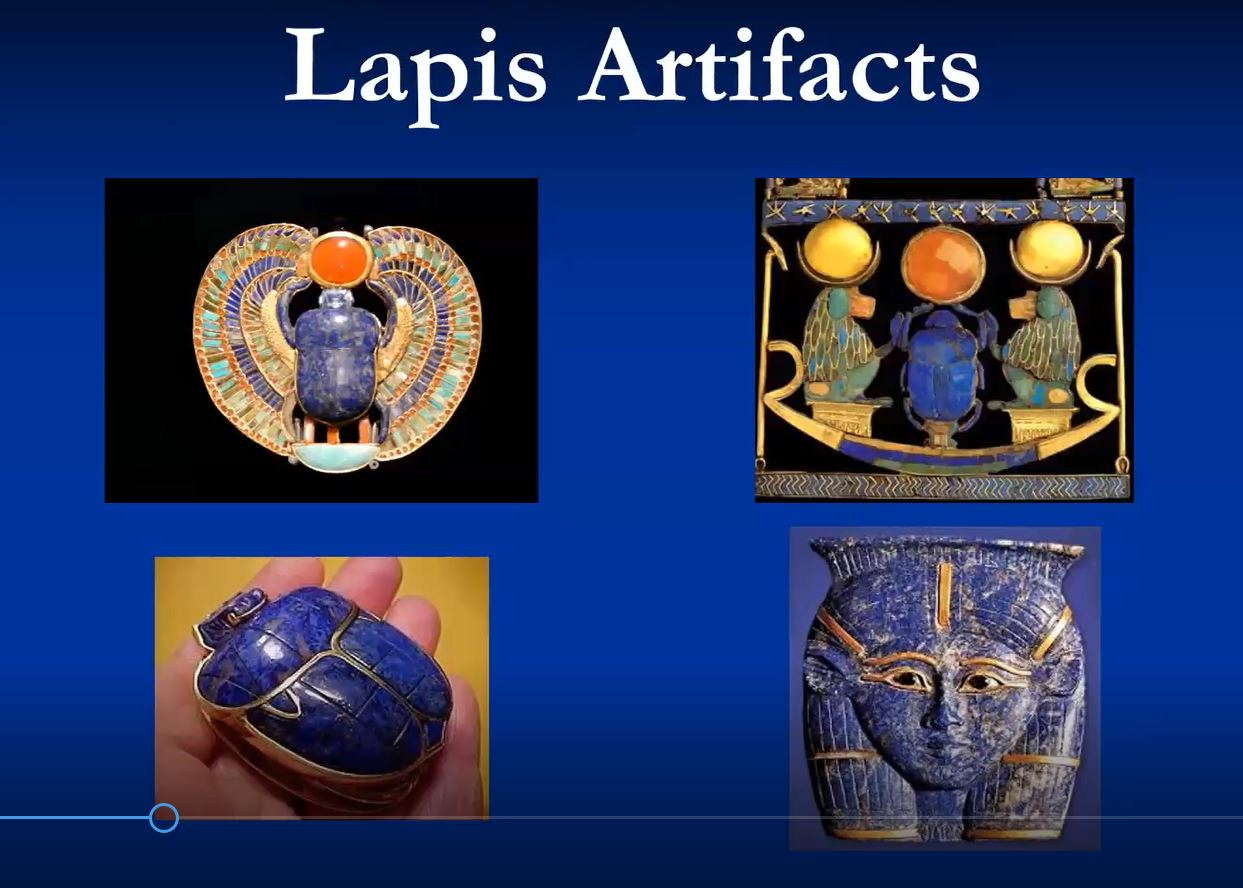
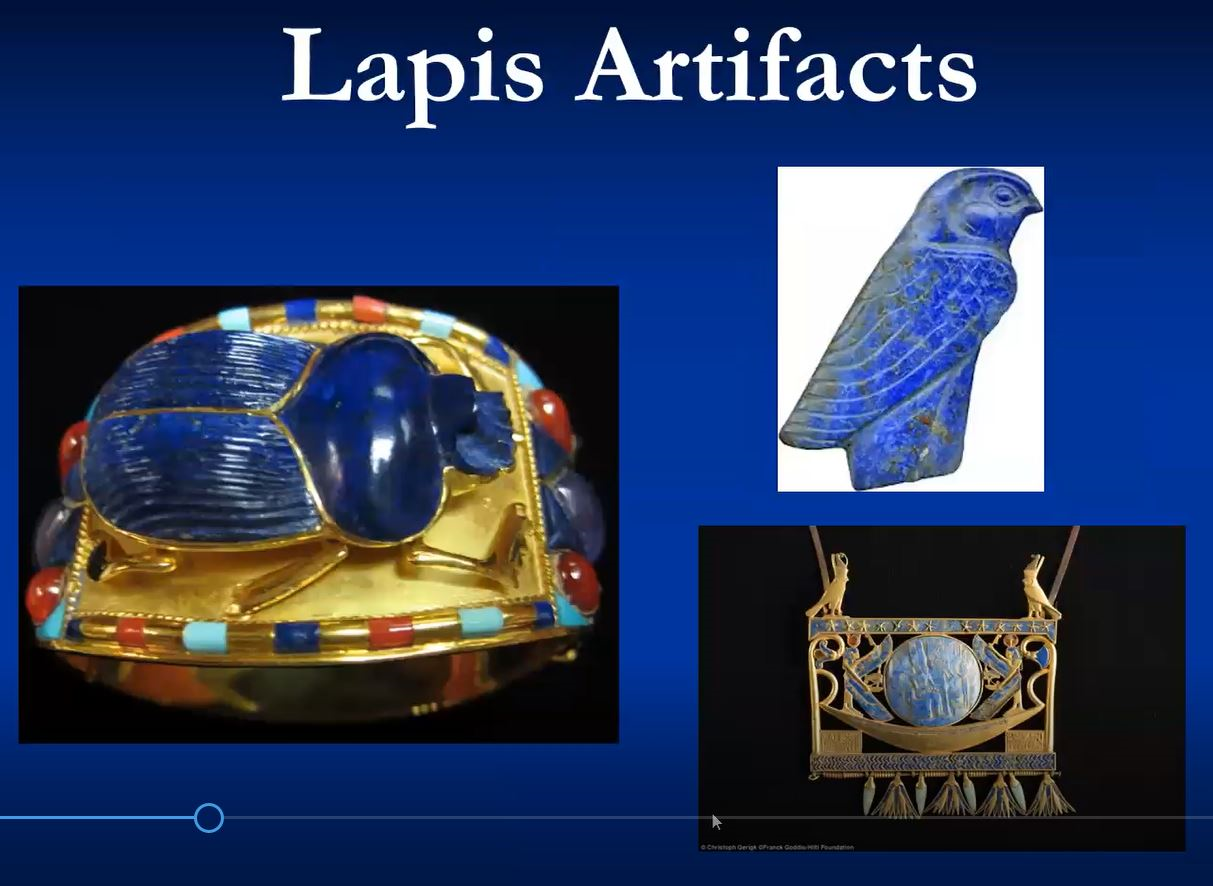
Carnelian
Carnelian, the second of the four materials, is the brownish-red mineral which the Egyptians used for carving various images related to royalty and divinity.
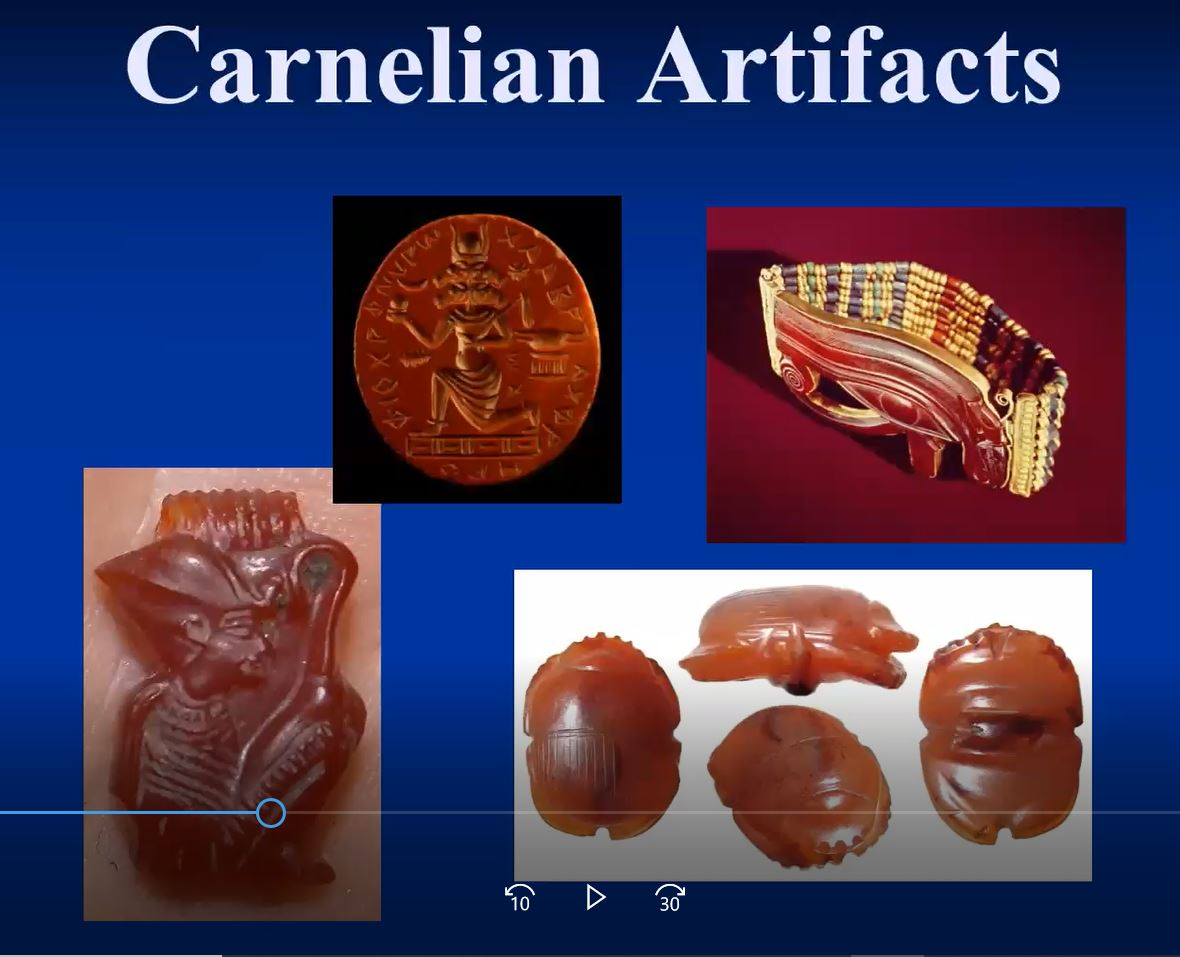
In the images below, carnelian was made into a cabochon representing the sun. But it also served practical purposes, such as intaglio rings that were used as seals impressed on warm wax to seal official correspondence, as exemplified by the oval image shown above. Also shown are examples of carnelian carved into protective scarabs, found near the hearts of wrapped mummies.
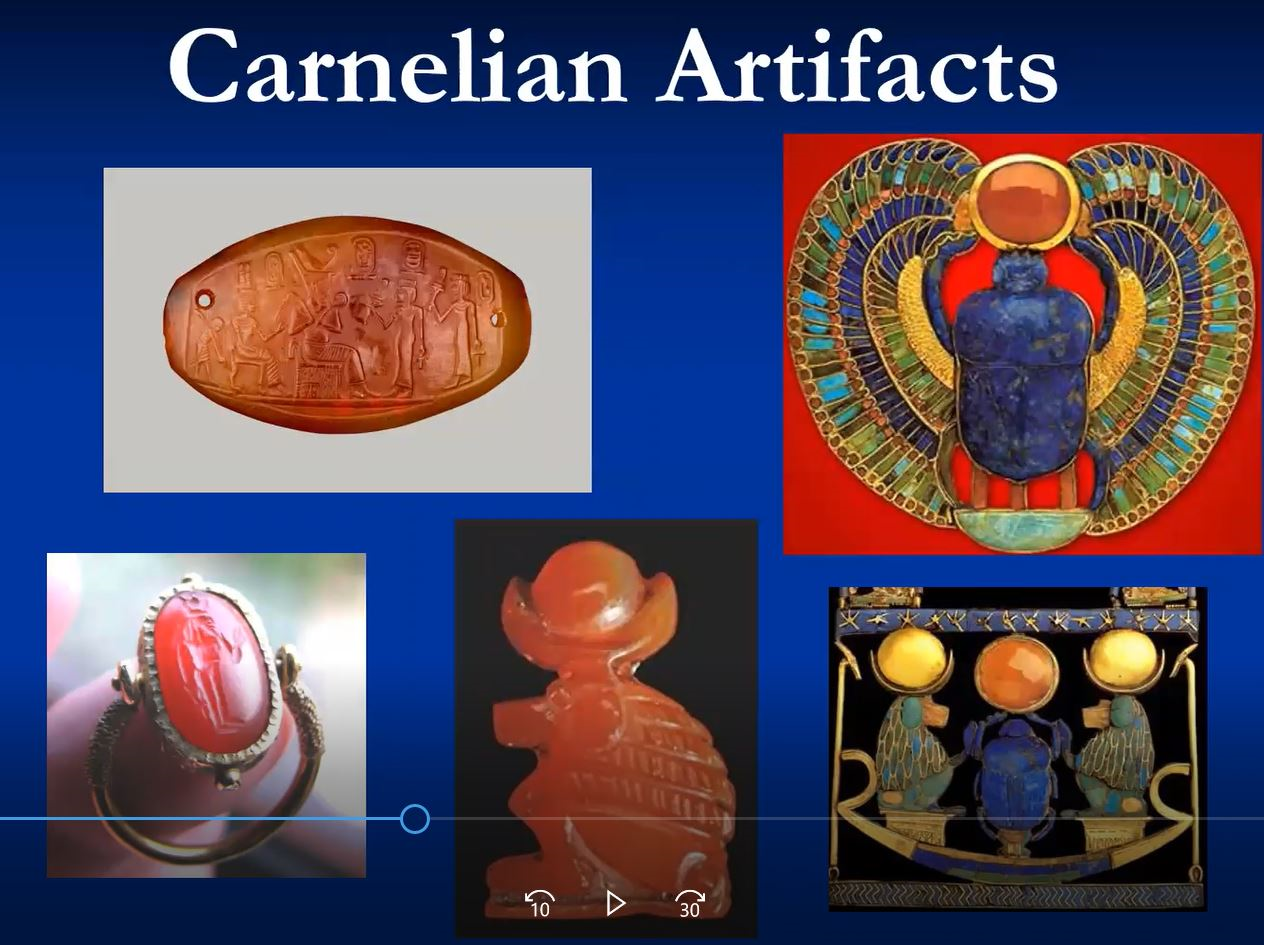
Derek suggested that the source of the carnelian was probably the banks of the Nile. Unlike lapis, carnelian was collected locally from the water’s edge. Of the five artifacts shown in the image, Derek singled out the first one, detailed in the image to the left, for particular comment.
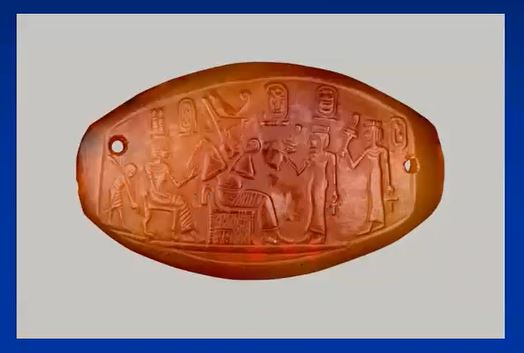
“This kind of thing is incredible to me. Being someone who does lapidary, this particular bead is only two inches long. How they were able to carve this intricate design into something as hard as carnelian, without the use of diamond or abrasive bits is beyond my comprehension.”
Persian Turquoise
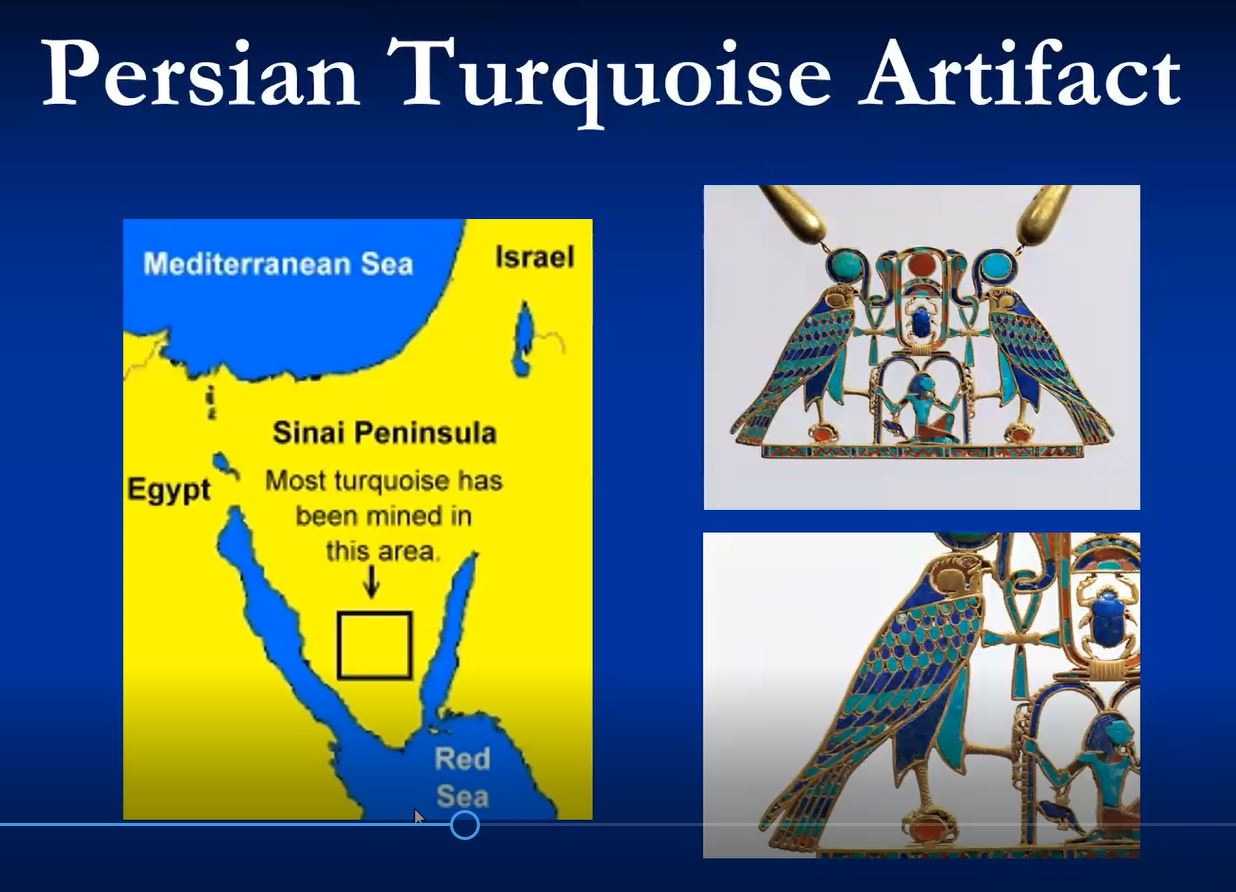
The third of the four most common materials found in Egyptian jewelry and artifacts is known as Persian turquoise. The mineral is so-named because historically it had been extensively mined in ancient Persia, in the region known today as Iran. The Egyptians mined this distinctive blue-green-colored mineral, as shown on the map above, mostly in the Sinai desert peninsula just north of the Red Sea.
The Egyptian pendant jewelry is shown above, Derek pointed out, includes Persian turquoise, as well as lapis, carnelian, and gold. He noted that of the four materials, three are relatively soft as designated on the Mohs scale, and only the carnelian is harder, in the 6 to 7 range (between orthoclase feldspar and quartz).
Libyan Glass
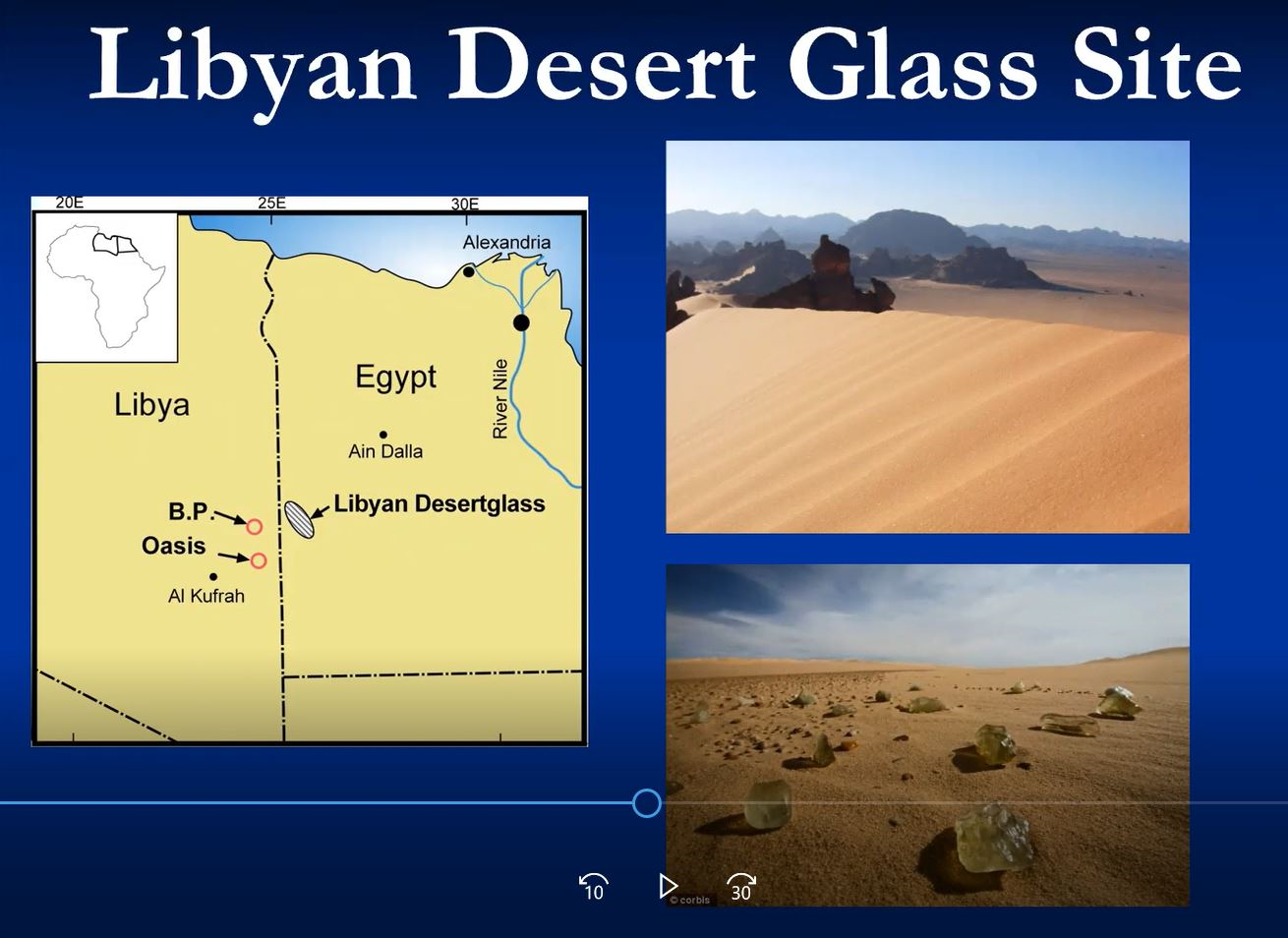
Before turning to the abundant gold artifacts from Egypt, Derek called attention to two additional and somewhat mysterious minerals that played unique roles in the Egyptian culture, the first being Libyan glass.
As indicated on the map, it has been found in the southern desert of Egypt, near the border with Libya. The site has yielded an unusual light green mineral whose identity was initially uncertain. Some thought it was a light green variety of carnelian. A beautiful example of this desert glass was recovered from King Tut’s tomb, discovered by Harold Carter in 1920.
Cabochon specimens are included in Tut’s breastplate jewelry, pictured below.
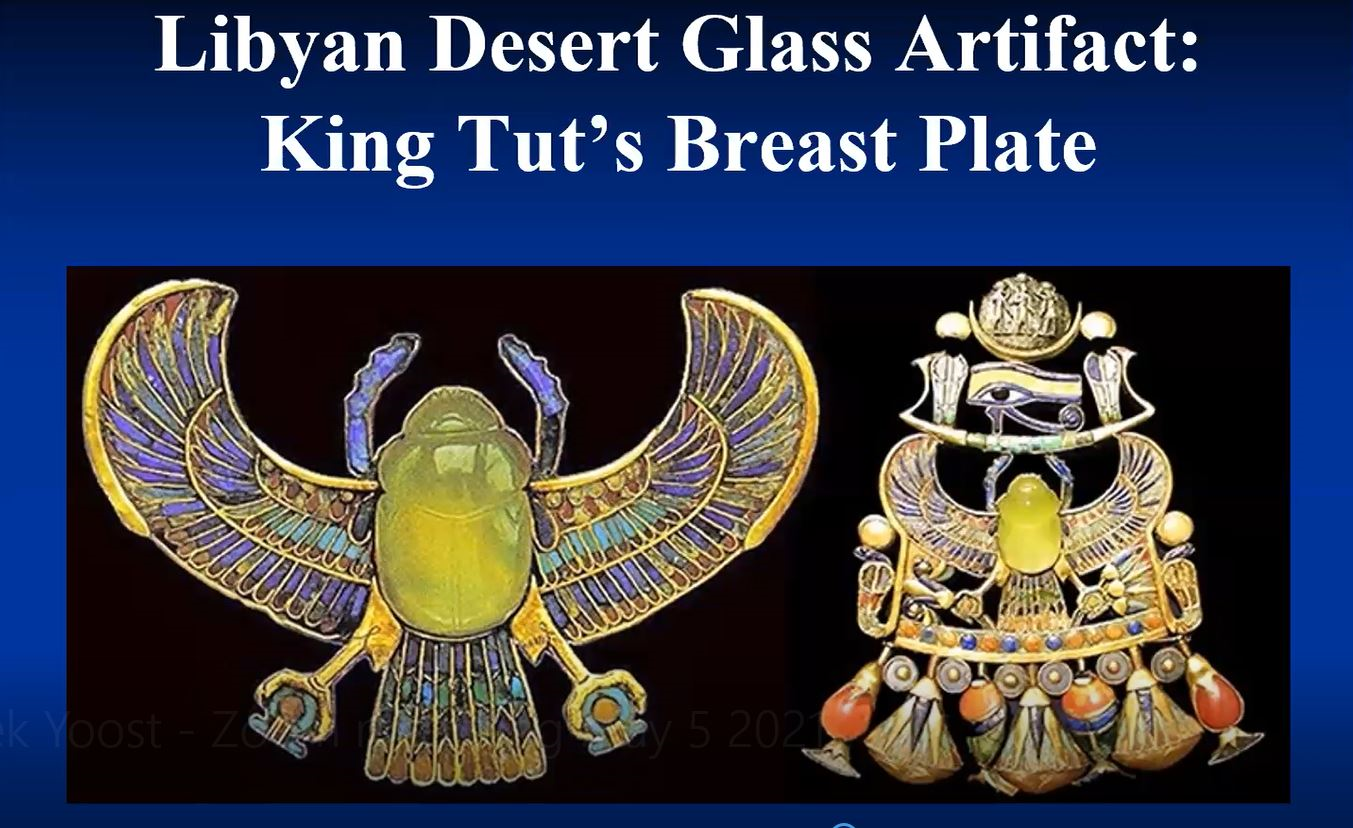
More recent testing of this material documented that it is actually glass, probably generated by a meteorite. Given that the Libyan glass is not found near a crater, scientists concluded that the incoming meteor exploded above the ground with the heat melting the surrounding sand, similar to the tektite generated by the heat of another meteorite impact (also by the 1945 testing of the first atomic bomb at Los Alamos, New Mexico). Some of the Egyptian specimens have dark inclusions, now understood to be tiny fragments of the exploded incoming meteorite.
Iron
Researchers found that the Egyptians used a second mysterious material also found in the southern Egyptian desert, but closer to the border with Sudan, as shown in the map below. It was in very short supply.
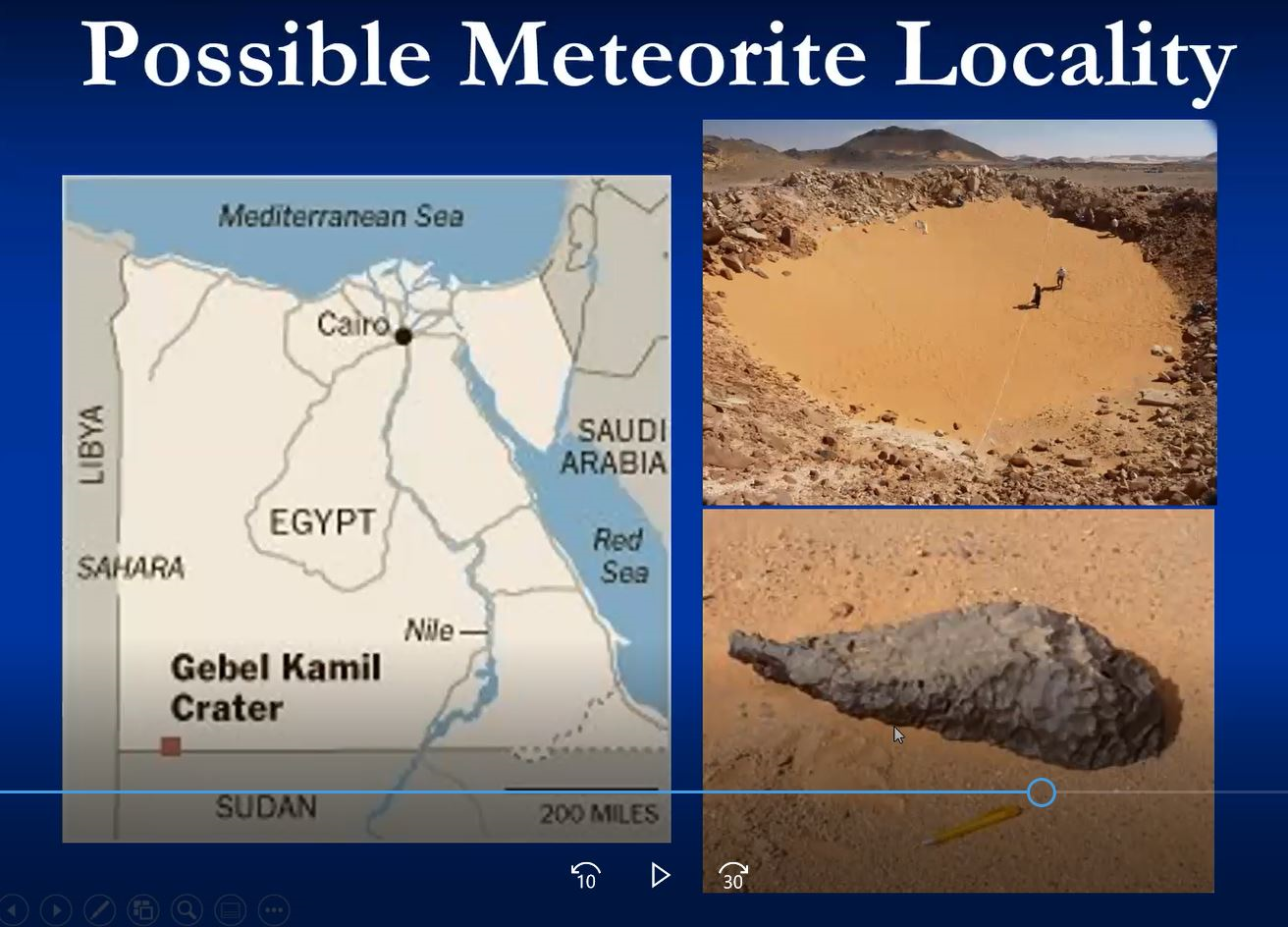
This second mysterious material Derek mentioned was iron, a puzzling find given there were no iron mines found in Egypt or its neighboring countries. So, what was its source? Adding to that mystery was the fact that examples of Egyptian iron were rare and found essentially only in the tomb of King Tut, in the form of iron daggers with handles and sheaths composed of high-carat gold. Derek explained that testing resolved this mystery as well because this iron had a high content of nickel, characteristic only of certain meteorites.
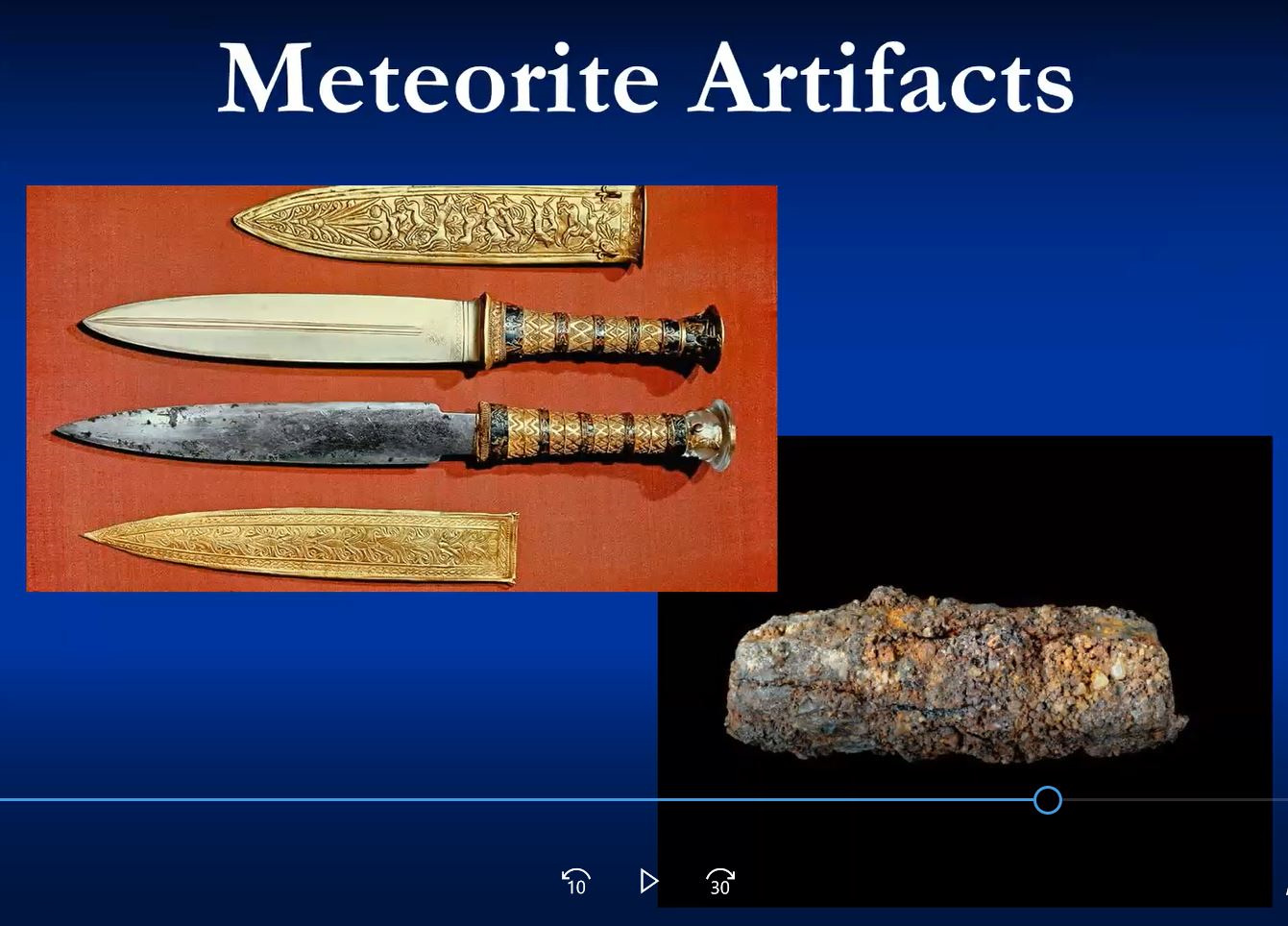
This meant that King Tut, during his life, wore jewelry featuring two materials which, so to speak, came from beyond the earth: one, from a meteorite which generated Libyan desert glass, and another, directly from an iron-nickel meteorite seen in the daggers shown in the photos above.
High-carat Gold
The gold-laden dagger handles provided a smooth transition to Derek’s discussion of the fourth and final major mineral of his presentation, high-carat gold.
From the very first mineral discussed in this presentation, lapis lazuli, to the carnelian and Persian turquoise jewelry, many of these artifacts were surrounded by gold. Derek noted that gold was commonly found in the royal artifacts, not only in jewelry, but also on a much larger scale. Tut’s royal chair for example, shown on the next page, had a wood structure topped with an application of gold foil.
The triple nested sarcophaguses in which Tut was buried had an innermost coffin made entirely of 243 pounds of high-carat gold. Clearly, in contrast to lapis, the ancient Egyptians had an abundant supply of gold which made lapis more expensive than the readily available gold.
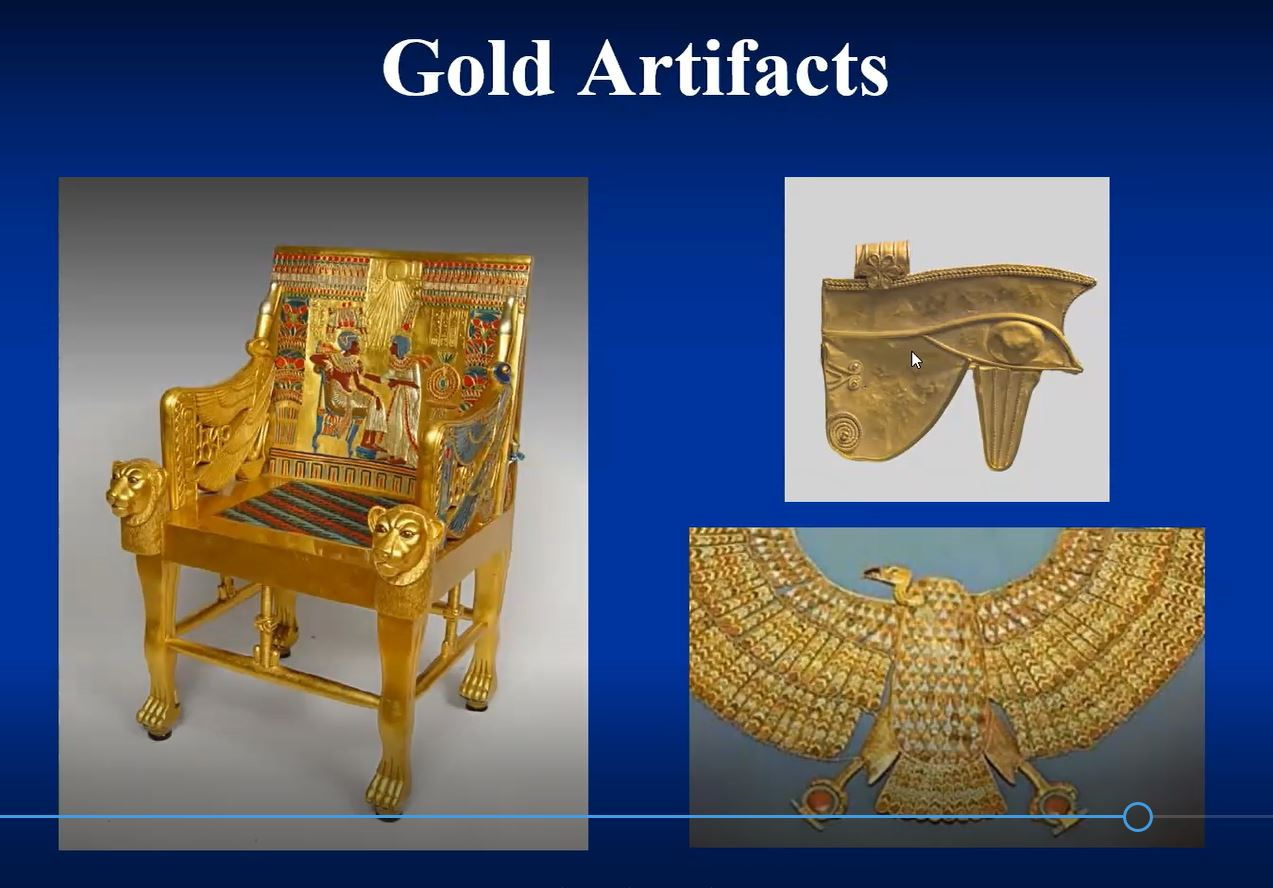
Similarly, the famous death mask of Tut, pictured in the first slide at the beginning of Derek’s presentation, was made of 22 pounds of high-carat gold. And even that highly important head-piece has extensive inlays of lapis lazuli, suggesting lapis was used exclusively for Egyptian royalty.
Derek noted there were additional gemstones of ancient Egypt, including the ground-breaking manufacturing of Faience (glass jewelry) and the common use of amethyst.
At that point in his presentation, Derek generously shared examples of his personal collection of Egyptian minerals. His “show and tell” was joined by MSDC attending members spontaneously showing their own Egyptian-related collectibles, providing an extensive display of interesting and impressive specimens.
Discussion
MSDC President Dave Hennessey thanked Derek for his excellent presentation and invited members to ask questions. Typical of our group, there were many, encompassing the following topics:
- Discussion of how some paintings of the middle ages and renaissance, including some found in the Sistine Chapel, used azurite blue pigment. Azurite was less expensive than lapis pigments. Painters with less money used azurite, which, as a copper-based pigment, is less stable than lapis.
- Azurite gradually changes to malachite via a weathering process that involves the replacement of some of azurite’s carbon dioxide molecules with water (changing the carbonate to hydroxide ratio from 1:1 of azurite to the 1:2 ratio of malachite), resulting in a color shift towards green. This conversion of azurite into malachite is attributable to the low partial pressure of carbon dioxide in air.
- The approximate date of the creation of the Libyan desert glass via the meteorite air explosion was roughly 29 million years ago.
- Additionally, questions for Derek included, but were not limited to, where the Egyptians obtained their gold (trade with neighboring African and Mediterranean countries), the significance of the pharaonic beard (masculinity), the surprising absence of peridot in Egypt, the modern-day abundance of reproductions for sale to tourists, Derek’s future presentation on meteorites, Russian sources for buying Libyan glass, and whether lapis fluoresces (it does not).
Dave Hennessey once again thanked Derek Yoost for his excellent presentation and for fielding all the participants’ questions. The audience signaled their appreciation with applause (Zoom style silent clapping). Dave thanked all for attending and participating.
